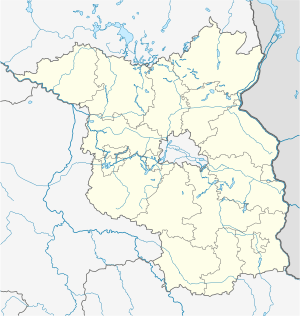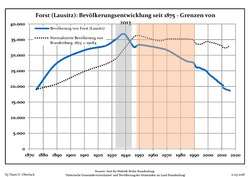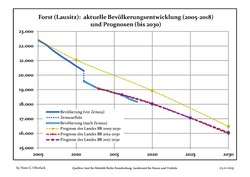Forst (Lausitz)
Forst (Lausitz) (Lower Sorbian: Baršć) is a town in Brandenburg, Germany. It lies east of Cottbus, on the river Lausitzer Neiße which is also the German-Polish border, the Oder-Neisse line. It is the capital of the Spree-Neiße district. It is known for its rose garden and textile museum. The town's population is 18,651. In Forst, there is a railway bridge across the Neiße belonging to the line Cottbus–Żary which is serviced by regional trains and a EuroCity train between Hamburg and Kraków (2011). There is also a road bridge across the river north of Forst.
Forst (Lausitz) | |
|---|---|
 Watertower in Forst | |
.svg.png) Flag .svg.png) Coat of arms | |
Location of Forst (Lausitz) within Spree-Neiße district _in_SPN.png) | |
 Forst (Lausitz)  Forst (Lausitz) | |
| Coordinates: 51°44′N 14°38′E | |
| Country | Germany |
| State | Brandenburg |
| District | Spree-Neiße |
| Government | |
| • Mayor | Simone Taubenek |
| Area | |
| • Total | 109.91 km2 (42.44 sq mi) |
| Elevation | 72 m (236 ft) |
| Population (2018-12-31)[1] | |
| • Total | 18,164 |
| • Density | 170/km2 (430/sq mi) |
| Time zone | CET/CEST (UTC+1/+2) |
| Postal codes | 03141–03149 |
| Dialling codes | 03562 |
| Vehicle registration | SPN |
| Website | www.forst-lausitz.de |
Overview
Part of the region of Lusatia, Forst was awarded to the Kingdom of Prussia in the 1815 Congress of Vienna. The town was subsequently administered within the Province of Brandenburg. After World War II it became part of the German Democratic Republic.
Forst has experienced severe problems as a result of the 1990 German reunification, most notably from extreme unemployment. In the past, the town was known for textile manufacturing, but all of the textile plants and factories have closed down.
History
A short distance to the south of the old Sorbian village of Altforst, the town probably originated around 1150 at a river crossing point on the important west-east route (known as the Salzstraße / Salt Road) connecting Halle and Głogów. By 1265 it was developing into a permanent trading settlement round the Church of St Nicholas. The commercial importance of Forst increased with the development of a north-south route connecting to Guben, downstream along the Neisse River. In the fourteenth century the council was able to take on responsibility for the lower courts locally. In 1352 of Ileburg took over the overlordship of Forst from Frederick III of Meißen.
Demography
 Development of population since 1875 within the current Boundaries (Blue Line: Population; Dotted Line: Comparison to Population development in Brandenburg state; Grey Background: Time of Nazi Germany; Red Background: Time of communist East Germany)
Development of population since 1875 within the current Boundaries (Blue Line: Population; Dotted Line: Comparison to Population development in Brandenburg state; Grey Background: Time of Nazi Germany; Red Background: Time of communist East Germany) Recent Population Development and Projections (Population Development before Census 2011 (blue line); Recent Population Development according to the Census in Germany in 2011 (blue bordered line); Official projections for 2005-2030 (yellow line); for 2014-2030 (red line); for 2017-2030 (scarlet line)
Recent Population Development and Projections (Population Development before Census 2011 (blue line); Recent Population Development according to the Census in Germany in 2011 (blue bordered line); Official projections for 2005-2030 (yellow line); for 2014-2030 (red line); for 2017-2030 (scarlet line)
| Forst (Lausitz): Population development within the current boundaries (2017)[2] | |||||||||||||||||||||||||||||||||||||||||||||||||||||||||||||||||||||||||||||||||||||||||||||||||||||||||||||||||||||||||||||||||||||||||
|---|---|---|---|---|---|---|---|---|---|---|---|---|---|---|---|---|---|---|---|---|---|---|---|---|---|---|---|---|---|---|---|---|---|---|---|---|---|---|---|---|---|---|---|---|---|---|---|---|---|---|---|---|---|---|---|---|---|---|---|---|---|---|---|---|---|---|---|---|---|---|---|---|---|---|---|---|---|---|---|---|---|---|---|---|---|---|---|---|---|---|---|---|---|---|---|---|---|---|---|---|---|---|---|---|---|---|---|---|---|---|---|---|---|---|---|---|---|---|---|---|---|---|---|---|---|---|---|---|---|---|---|---|---|---|---|---|---|
|
|
| |||||||||||||||||||||||||||||||||||||||||||||||||||||||||||||||||||||||||||||||||||||||||||||||||||||||||||||||||||||||||||||||||||||||
People
- Hugo Baum (1867 - 1950), botanist
- Georg Thomas (1890–1946), general of infantry
- Bruno Kastner (1890–1932), film and stage actor
- Max Seydewitz (1892–1987), politician (SPD, SED)
- Brigitte Frank, née Herbst (1895–1959), wife of Hans Frank
- Erich Neumann (1892–1948), politician (NSDAP)
- Werner Heyde (1902–1964), psychiatrist, involved in the T 4 program
- Georg Bose (1921–2011), German officer during World War II,
- Günter Nooke (born 1959), politician (CDU)
- Dietmar Woidke (born 1961), politician (SPD)
- René Rydlewicz (born 1973), footballer
- Ronny Scholz (born 1978), cyclist
See also
References
- "Bevölkerung im Land Brandenburg nach amtsfreien Gemeinden, Ämtern und Gemeinden 31. Dezember 2018". Amt für Statistik Berlin-Brandenburg (in German). July 2019.
- Detailed data sources are to be found in the Wikimedia Commons.Population Projection Brandenburg at Wikimedia Commons
External links

- Official website of Forst (Lausitz) (in German)
- Forst's Rose Garden (in German)
- . Encyclopædia Britannica (11th ed.). 1911.
- . New International Encyclopedia. 1905.